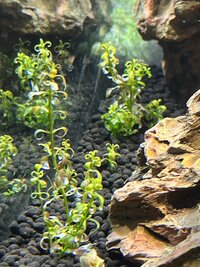1000 PAR plus will do it. It’s cool to see the environmental adaptations packed so tightly. Amazonia type 1 and Solar RGB’s central (200 PAR) and you would see the same over 3 inches of growth on macrandra.
I am actually wondering if they won’t grow in the top 1/3 … or if they will look absolutely stunning. Or flower …
Initial plant growth has had their life line cut, white as snow. Up to you but would trim those bits off if it’s feasible, although can see against the scale of the soil it might be too tiny to get scissors on.
Scissors are giants compared to them, fingers also. If I had a team who would do it for me, it would be worth it - provided they didn’t disturb the substrate or roots.
Myself: I’ll start, my hand will slip or scissors will, the plant will get up rooted and we are 1 step forward 10 steps back (re anchoring stress etc). I’d probably get frustrated.
Knowing myself is in part why I automated water change. Provided I play the proactive game, I can just relax, enjoy the tank, and finger-thumb prune as needed to get plant forms and shapes I want.
Easier to do early on before new growth smothers it. Could just wait for it to decay and get jettisoned off… but if it gets tangled up you’ll have decaying organics right next to fresh growth, not ideal. Quick blast with a turkey baster at the one month mark? Knock it all off. Probably overkill as you’re doing the water changes.
It’s all correct I’d say from a waste-management perspective. If my daughter was a bit older, I’d go through it with her to be honest but right now it’s just me “doing” and can probably get away without sinking the time into it.
In ~ 1-2 months like you say, I think I’ll have enough growth, just waft my hand and get all those ghostly leaves airborne into the pump.
Have seen carpets of Cryptocoryne in the jungle in the Philippines getting blasted at noon. What holds as reasonably true in a tank doesn’t necessarily stand in the wild. Photo inhibition at midday is necessary, the same is being found with corals.
You know now I am wondering if photoinhibition does occur then in theory I don’t need co2 at some point during photo period … uh oh don’t make me turn it off 😂.
Makes your tank interesting to see what species can adapt to an environment where maximal levels are available for the majority of the day. If there’s a stem plant that is easily photographed, daily pictures from the same spot would be cool.
Been trying will catalogue best I can.
That PAR is only getting higher the closer it gets to the light source. However, everything under the shield of new growth will benefit from the shading. Seems forgotten that plants change their environment. You can’t turn off the sun.
Wonder what will be in the top 1/3 like I said - what’s your intuition Geoff? Death or beauty?
On individual shots: it’s very hard to get them because of the water, hardscape in my way lol, and my camera, and also user skills of course. But I am questioning: why aren’t they getting taller, then when we look, there are way more side shoots than I’d ever expect … and maybe others can say they have seen it this early but I haven’t.


It’s nearly at every single node. The only way I’ve done this is under high light (close to surface) and with EI. High light (close to surface) with low N/P didn’t work as well as EI did. Now, the substrate at the time was not this potent and flow was not this good … so perhaps nutrient (light, fert, co2) abundance and availability (summed over soil and column without issues of acquisition) is the key.
Side shoots = density
Early side shoots = staying petite/elegant
Red coloration = pretty
If this works … or when … grin.











